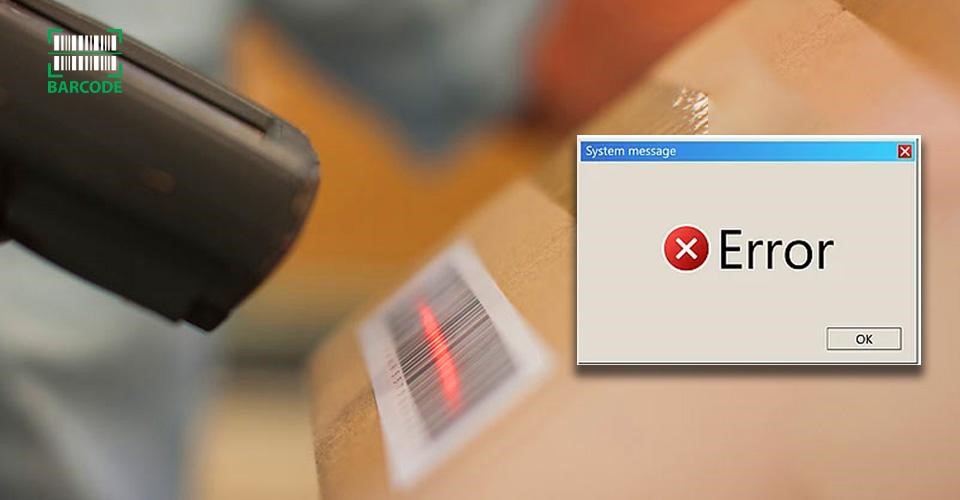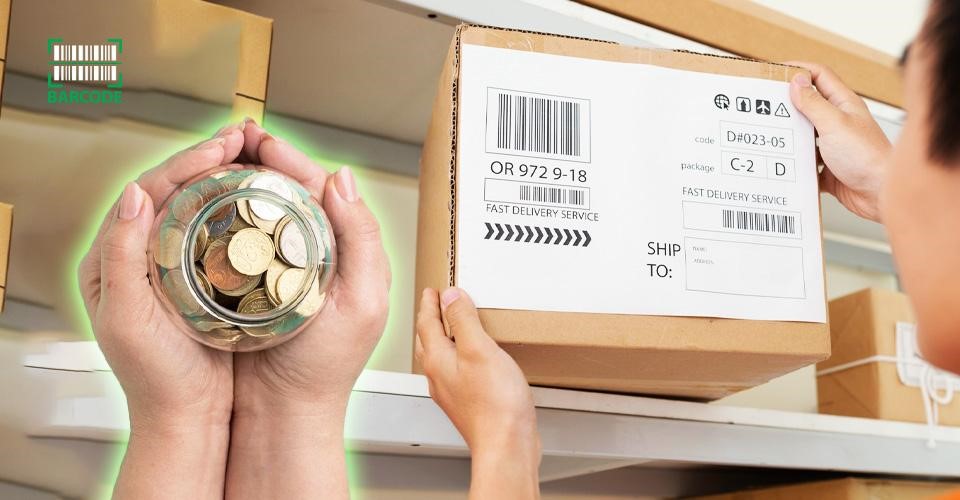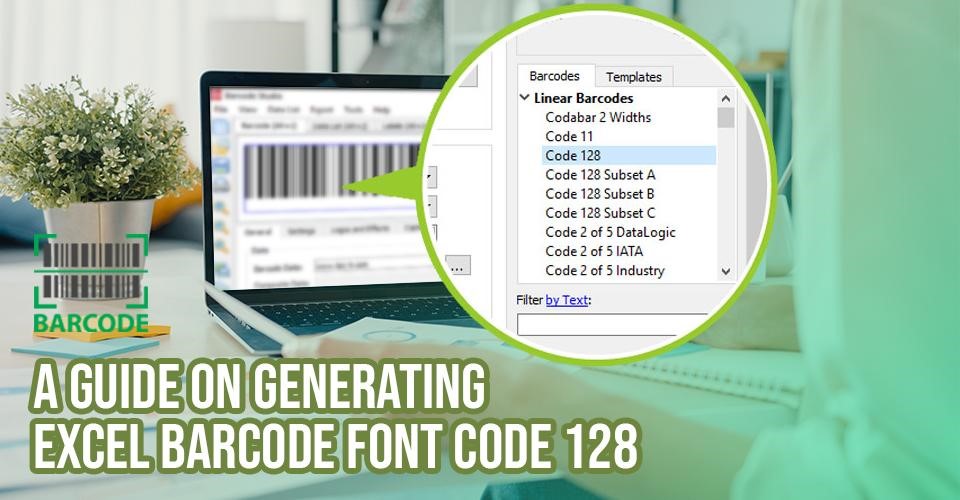How to Create a Barcode For a Product With and Without GS1?
In this article, we'll cover everything you need to know about how to create a barcode for a product, including the different types of barcodes available, the benefits of using barcodes, and step-by-step instructions for creating your own barcode.
So, if you're looking to improve your business operations with the use of barcodes, read on to learn how to create an effective barcode for your product.

How to create a barcode for a product?
Types of Barcodes
Barcodes are ubiquitous in modern society and are used for a variety of applications.
There are several types of barcodes, each with its own unique features and use cases. They include:
EAN-13
EAN-13 barcodes are commonly used in supermarkets and retail stores around the world.
These barcodes consist of 13 digits, with the first three indicating the country code, followed by the next five digits for the producer code, the next five for the article code, and a final check digit.

EAN-13
EAN-13 barcodes can be generated using a barcode generator EAN-13, which allows businesses to create their own unique barcodes for their products.
These barcodes are read by POS terminals, which can quickly and accurately retrieve information about the product, such as its price and stock level.
They have become an essential part of the retail industry, enabling businesses to efficiently manage their inventory and provide a seamless shopping experience for customers.
Code 39
It is a variable-length barcode that is widely used in manufacturing and logistics applications.
This type of barcode can encode a set of 43 allowable characters, including uppercase letters, numerals 0-9, and special characters.
It is capable of encoding both numbers and text, making it a versatile option for a wide range of applications.

Code 39
This code is relatively easy to read and decode, making it a popular choice for businesses that need to track inventory or manage logistics.
In addition to its versatility and ease of use, the Code 39 barcode is also known for its high level of accuracy and reliability, which makes it a trusted choice for many businesses.
Code 128
Another type of barcode is Code-128 which is commonly used in logistics, transportation, and distribution applications.
It is capable of encoding a broad range of characters, including all ASCII 128 characters.

Code 128
The Code 128 barcode can encode not only alphanumeric characters but also punctuation marks, pronunciation marks, and special characters, allowing for even greater flexibility in its use.
This makes it a popular choice for businesses that need to track and manage inventory, shipments, and other logistical information.
Because it can encode a large number of characters, it is especially useful for applications that require a high degree of accuracy and reliability, such as in the shipping and transportation industries.
UPC-A
UPC-A is a type of barcode that is commonly used in retail applications.
This barcode is made up of a series of bars and spaces that encode information about the product, including its manufacturer and product number.
The UPC-A barcode can be scanned by a barcode scanner, allowing retailers to quickly and accurately retrieve information about the product at the point of sale.

UPC-A
This barcode has become an essential part of the retail industry, enabling businesses to efficiently manage their inventory and provide a seamless shopping experience for consumers.
With the help of the UPC-A barcode, consumers can quickly and easily identify products and make informed purchasing decisions.
ITF
ITF, or Interleaved Two of Five, is a type of barcode that is widely used in the logistics and transportation industries.
This barcode is a visual identifier that can be used to track and manage items as they move through the supply chain.
ITF barcodes are capable of encoding a variety of information, including the Global Trade Item Number (GTIN) and other product identifiers.

ITF-6 barcode
These barcodes can be generated using a barcode generator, which enables businesses to create unique codes for their products and items.
With the help of ITF barcodes, businesses can more easily manage their inventory, track shipments, and ensure that items are correctly identified and labeled throughout the supply chain.
Codabar
This type of barcode symbology is commonly used in applications where easy printing and photo reproduction are necessary and in environments such as medical labs, blood banks, and FedEx airbills.
The Codabar symbology encodes up to 16 characters, including numbers, letters, and special characters.
One of the unique features of this barcode is that it is a self-checking barcode, which means that it can detect errors that occur during scanning.
This minimizes the risk of incorrect data being registered due to a wrong scan.

Codabar barcode
With the help of Codabar barcodes, businesses can streamline their operations and minimize scanning errors, ensuring that the data being registered is accurate and reliable.
The Codabar barcode is an important tool for businesses and organizations that need to manage large amounts of data and ensure that the information they are registering is correct and up-to-date.
Why are Barcodes Used?
Barcodes have become a ubiquitous part of modern life, used in everything from retail to logistics and transportation.
But why are barcodes so popular, and what benefits do they offer to businesses and consumers?

Advantages of using barcodes
Real-time data
One of the key benefits of barcodes is the real-time data they provide.
When an employee scans a barcode, the system updates the inventory and sales records in real-time, allowing the company’s enterprise resource planning (ERP) system to have constant access to up-to-date data.
It also enables business management to quickly calculate meaningful metrics such as inventory on hand and sales by week or item.
This real-time data is critical for businesses to make informed decisions and respond quickly to changes in the market.
With the help of barcodes, businesses can better manage their operations and improve their bottom line by making informed decisions based on real-time data.
Accuracy

Barcode reduces the opportunities for error
Barcodes are used because they eliminate manual entry, which reduces the opportunities for error.
For example, when a product is received in a retail store or warehouse, associates can simply swipe the barcode with a scanner, rather than manually entering the product information into the system.
This significantly reduces errors that can occur during data entry, such as typos or transposed numbers.
While errors can still occur with barcodes, they are much rarer than with manual data entry.
This accuracy is critical for businesses that need to manage large amounts of data and ensure that their records are correct and up-to-date.
Less training time
Another reason barcodes are used is that they require less training time for employees.
Barcodes and scanners are self-explanatory and don’t require a lot of training or institutional knowledge.
This makes it easier for businesses to train new employees and get them up to speed quickly.
In a retail environment, for example, barcode scanners make the checkout process more efficient and reduce the need for employees to memorize product codes.
This greatly reduces the amount of institutional knowledge that employees need to have and makes it easier for businesses to operate efficiently.
Inventory control

Barcodes are used in inventory control
Barcodes are also used to improve inventory control and reduce excessive spending on products.
By using barcodes to track inventory, employees can easily keep current on what products are in stock and review inventory positions and trends in demand.
This facilitates better decisions about purchasing, discounting, and cutting inventory carrying costs, including obsolete inventory.
By improving inventory management through barcodes, businesses can reduce their costs and boost long-term profitability.
Cost-effective
Another reason why barcodes are used is that they offer tremendous cost-effectiveness for businesses.
The upfront investment required for implementing a barcode system is minimal compared to other systems that offer comparable benefits.
This makes it easier for companies of all sizes to create and implement a barcode system.
While there may be some limited costs associated with barcodes, such as internal staff training or barcode generator software, the overall price is still reasonable.

Using a barcode is cost-effective
How to Create a Barcode For a Product?
How to create a barcode for my product? Follow these 3 easy steps
Create your product codes
The alphanumeric and symbolic sequences you provide your products with to act as IDs are referred to as product codes.
UPCs and SKUs are the two main categories of product codes.
The type of business you run and the requirements you have for inventory tracking will determine the ideal stock coding or numbering system for you.
Here, we'll look more closely at each product coding choice and its applications.
-
UPCs
Consider signing up with the GS1 and obtaining UPCs if you sell privately labeled goods under your own brand or your own products that you manufacture.
The majority of products that retailers buy from manufacturers come with UPCs and matching barcodes already affixed.
This code is exclusively for the retail supply chain; it is not the code you will use internally or the barcode you will scan in your POS system.

UPC vs SKU
-
SKUs
Internal SKUs are personalized alphanumeric numbers with different lengths (usually eight digits) that are created specifically for each store and tailored to your company's particular operations.
You can organize your inventory systematically using letters and numbers with an internal SKU system.
Make a barcode for each product
The next step is to enter your product codes into a system that converts them into scannable barcodes.
Barcodes create images that can be scanned by barcode scanners, saving you from having to put in individual product numbers.
You can determine how do I create barcodes for my products in three easy methods. They consist of:
Online barcode generators
A few websites will convert the product codes you enter into a barcode that you can download and store for later use. You can refer to the free online barcode generator Excel as well.

Barcode generator excel
Retail point-of-sale software
POS software like Square automatically generates a special barcode depending on the product SKU or UPC of each item.
Additionally, you can print your barcodes directly onto a product label from your POS account.
Mobile operations
They are made possible by portable barcode label printers, which allow you to quickly create a barcode for your labels by entering a product code.
Print your barcode labels

Using barcode printers to print your barcode labels
There are several options available for printing barcode labels, including specialized barcode printers or standard office printers.
Barcode printers are designed specifically for printing high-quality barcode labels quickly and efficiently.
Office printers can also be used, but they may require specialized software and label stock to ensure proper scanning.
When printing barcode labels, it's important to use high-quality materials to ensure that the labels will scan correctly.
How to Create Barcodes with GS1?
Make sure your barcodes are developed and registered with GS1 if your long-term goal is to sell your goods in other stores that employ various point-of-sale systems.
There are various levels you can buy based on capacity when registering a barcode with GS1. (i.e., how many of your products will need barcodes).

GS1 allows you to create barcodes
A GS1 US GTIN, which costs $30 for one barcode with no renewal fee, is the most economical grade.
This is a decent alternative for companies with a small number of items; however, before making a purchase, make sure to carefully read the GS1 US GTIN page as certain product categories are not permitted.
You should buy a company prefix from GS1 if you require more than nine barcodes for your products.
Regarding printing, you can print your labels by exporting the barcodes from the Data Hub.
Even though some users choose to send the picture files to a licensed GS1 service provider.
If you want anything more than just a basic label, they may assist you in designing and printing the barcodes that will be used on packaging or boxes.
1D barcodes are traditional, linear barcodes that contain a series of vertical lines and spaces of varying widths.
2D barcodes, on the other hand, contain a matrix of black and white squares arranged in a pattern. They can store much more data than 1D barcodes and can be scanned in any direction.
Choosing the right barcode depends on a variety of factors, including the type of product or item being tracked, the industry, and the desired level of data storage.
It's also important to ensure that the barcode can be read by the equipment being used, such as scanners or mobile devices.
Yes, some barcode types contain a country code as part of the information encoded in the barcode.
For example, EAN-13 barcodes, which are commonly used in retail, contain a country code as the first three digits. This code identifies the country or region where the product was manufactured or registered.
However, not all barcode types contain a country code. It depends on the specific format and purpose of the barcode.
Conclusion
Creating a barcode for a product is a relatively simple process that can provide numerous benefits to businesses, such as increased efficiency, accuracy, and cost-effectiveness.
By understanding the different types of barcodes available, as well as the unique requirements of their business, companies can select the appropriate barcode symbology and generate their barcodes using various software and online barcode generator tools.
If you're wondering how to create a barcode for a product, there are plenty of resources available to help you get started.



12 Comments
Lily Robinson
What steps must I take to purchase and implement a barcode on my product that I want to sell worldwide from UK?
Leave a Comment
Your email address will not be published. Required fields are marked *Barcodelive
GS1-UK is very expensive - with joining fees, annual fees, and then extra fees to create the barcode images. There are good alternatives - legal and legitimate companies that sell retail barcode numbers for a one-off cost.
Leave a Comment
Your email address will not be published. Required fields are marked *Charandeep Chaudhary
Are barcodes except from GS1 okay? What is the cost of getting barcodes in India?
Leave a Comment
Your email address will not be published. Required fields are marked *Barcodelive
You can get barcodes from GS1 or from any other vendors. You can even generate you own barcodes.
The cost of getting barcodes depends on the type of barcodes that you want. You can get non GS1 barcodes from many vendors for 5-10 thousand rupees. You can also create your own barcode numbers and use free online barcode generators to get the barcode and print them on your product packaging.
Leave a Comment
Your email address will not be published. Required fields are marked *aayushman subramanian
I am starting an FMCG business. Is a barcode of GS1 necessary, or can I have my own barcode? What if I use my own barcode, will the supermarkets accept that?
Leave a Comment
Your email address will not be published. Required fields are marked *Barcodelive
You can create your own independent barcode. However, no supermarket will allow you to insert your barcode directly into their software
Leave a Comment
Your email address will not be published. Required fields are marked *Alex
Always clever and straight to the point. Thank you for sharing such a treasure!
Leave a Comment
Your email address will not be published. Required fields are marked *Barcodelive
You’re welcome
Leave a Comment
Your email address will not be published. Required fields are marked *Damian Peterson
I sell products online and need to create barcodes but I am not sure of my company prefix. Is this something I need to pay for? Is there a database I can search for?
Leave a Comment
Your email address will not be published. Required fields are marked *Barcodelive
You need to get a prefix from GS1. Yes, a prefix from GS1 costs money. You don’t buy a prefix, you lease it. There are ongoing costs. If you don’t pay them, you lose all your prefixes.
Leave a Comment
Your email address will not be published. Required fields are marked *Lakshmi Chandran
Is it a crime to sell barcode without an associate with GS1 India, and also we create and selling non-GS1 India barcode to retail sellers?
Leave a Comment
Your email address will not be published. Required fields are marked *Barcodelive
In short no. The numbers that barcode resellers sell to their clients originate with the same system as GS1 barcode numbers and will therefore never be duplicated. They have never been assigned to a product and function in exactly the same way as codes issued by GS1.
Leave a Comment
Your email address will not be published. Required fields are marked *Leave a Comment
Your email address will not be published. Required fields are marked *